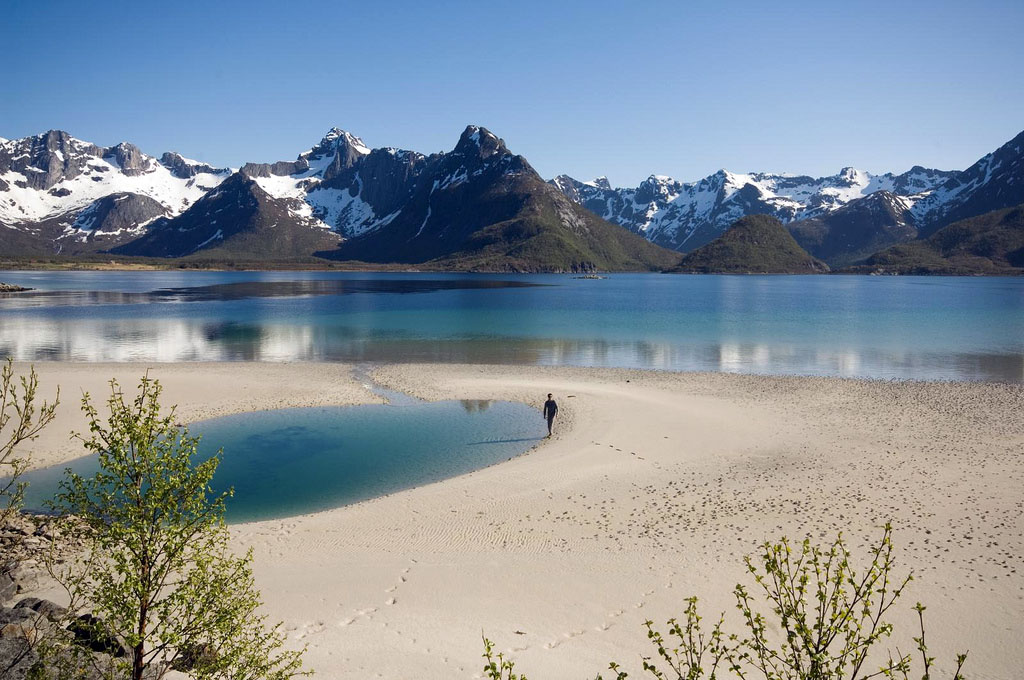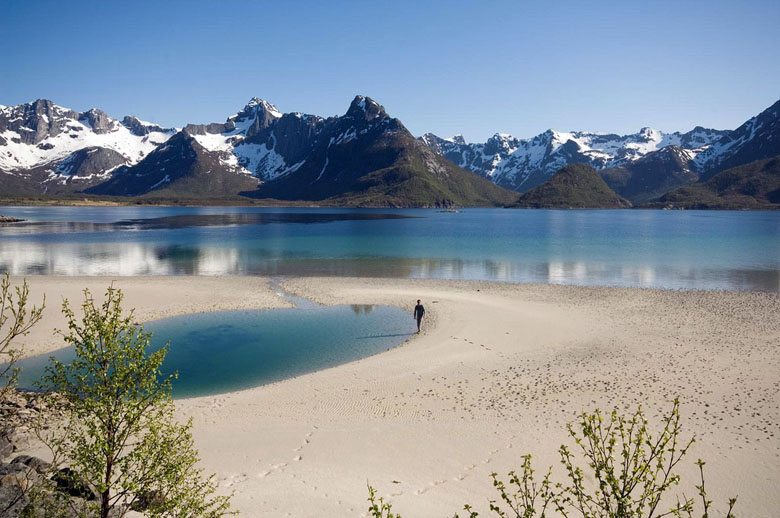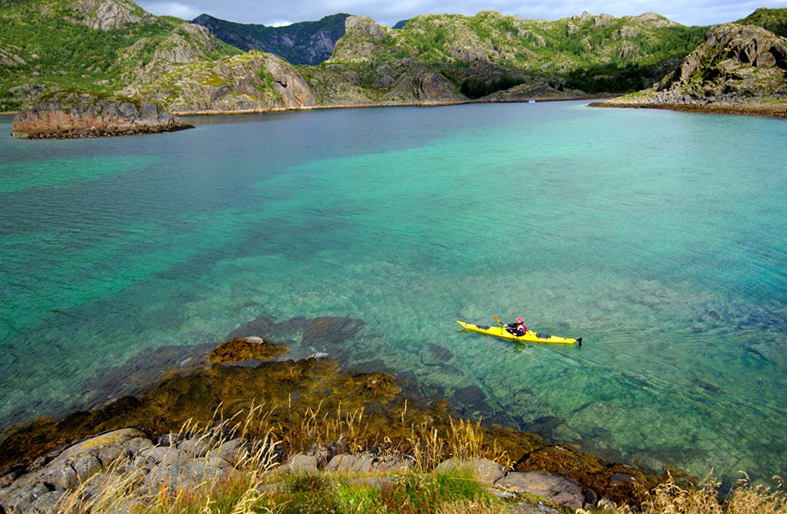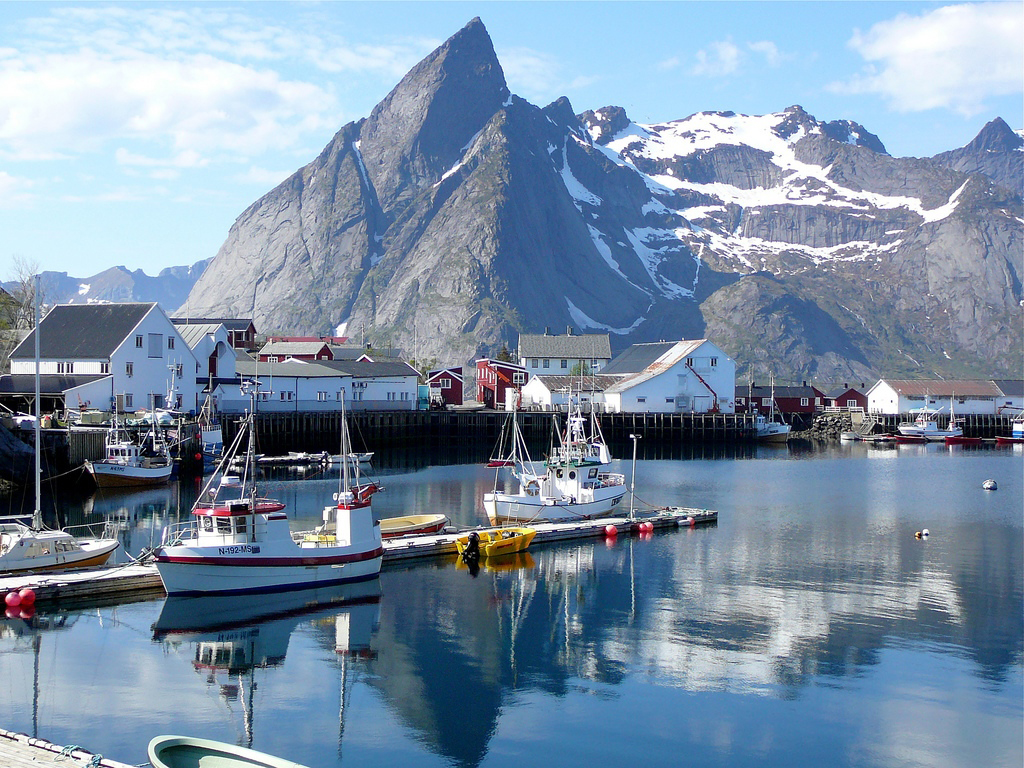

Thomas Faivre-Duboz


Thomas Faivre-Duboz
Despite the Arctic location, the Lofoten Islands present myriad ways to get outdoors, and no setting is cooler or more unique. You can bike scenic roads, kayak between fishing villages, climb sheer granite walls, fish like a local, camp on white sand beaches, and even surf above the 68th parallel north! All of these activities are aided by the midnight sun, which remains above the horizon from the last week in May until the first week in July.
Renting a bicycle is an excellent way to move around while taking in the the Lofoten scenery. The main road (E10) does get significant traffic in the summer but the side roads are far more tranquil, so plan your ride accordingly. Some of the classic rides include Svolvær to Henningsvær (26 km), Henningsvær to Stamsund (63 km), and Stamsund to Ballstad (27 km). Most accommodations offer bicycles, and Reine Adventure rents off-roads, hybrids, kids’ bikes, trailers, and panniers. It's a good idea to call or email ahead in the peak season.
The Lofoten Islands offer a grand stage for hiking, from short walks to challenging summit treks that can take a full day or more. For an in-depth breakdown of the best trails in the areas, see our article on hiking the Lofoten Islands. For maps, we recommend researching using the excellent digital platform by Norgeskart and buying a paper map from the DNT or locally in Lofoten.
Seeing the towering rock formations of the Lofoten Islands from the perspective of the water is mind-boggling. The interior waters are good for those with less experience; the outer currents can be quite strong (the Maelstrom off the Lofoten headlands is an extreme example). It’s smart to hire a guide but it’s also possible to paddle out on your own.

For a wonderful and relatively easy half-day trip, explore the many arms of the Reinefjorden (4 hours). Another good option is a kayak and hike combination to Bunes Beach: instead of taking the morning ferry to Vindstad you can get there in 1–1½ hours on a kayak (4–6 hours total for the trip, including the hike). Those seeking a full day on the water should consider the adventurous paddle from Reine to Å. Kayaking on the Lofotens is weather dependent so be watchful of the conditions.
Ed Webster’s celebrated guide, “Climbing in the Magic Isles” is a must-read for those seeking to scale the Lofotens, which are often mentioned among the world’s most majestic climbing destinations. A newer book, “Lofoten Rock” by Chris Craggs and Thorbjørn Enevold, has quickly gained the respect of the climbing community and won the 2008 Mountain Exposition Award at the Banff Mountain Book Festival.
RockFax reports that the Lofotens are home to “perfect grey granite.” Furthermore, “the developed climbing has barely scratched the surface of available climbable rock and yet the established routes are already regarded as some of the best multi-pitch granite routes on either side of the Atlantic.” For gumbies and veterans alike, the Lofoten Islands are a lifetime destination.
The popular Nord Norsk Klatreskole (North Norwegian School of Mountaineering) in Henningsvær offers everything from basic rock climbing lessons to guided ascents of the most challenging routes. It also provides reasonable accommodations in a hostel-like atmosphere and has a wonderful travelers café and bar. The School sells climbing gear, maps, and will help answer any questions you have about the area.
Fishing is life in the Lofotens, and nothing is more authentic than getting out on the water with a local veteran and experiencing it for yourself. Depending on the time of year, you can expect to haul in cod, haddock, wolf fish, and a range of others. Renting a fishing boat with a skipper for a 4-hour trip is a great way to go, and you may even spot orcas and eagles along the way.

In summarizing the Lofoten fishing experience, it would be difficult, if not impossible, to top the simple poetry of Lofoten Fisherman Adventures, who profess: “Nothing is as good as flat bread with butter and fresh fish straight from the gunwale.”
Sjøstrand Rorbuer & Fisk (3-hour trip, 550K per person)
Lofoten Fisherman Adventures (4-hour trip, 650K per person)
As with all Norway, you are free to camp anywhere on uncultivated land. A good camping spot with easy access can be found at the terminus of the E10 on the western edge of Moskenesøya. After driving through the village of Å to the parking lot at the end of the road, walk down the short path to the grassy area on the point. The wind can be strong, but when the weather cooperates the cliffside setting makes for terrific camping.
The most memorable camping on the Lofoten Islands may be the northern coast of Moskenesøya, on Horseid and Bunes beaches. With prime views of the midnight sun, camping on a glistening white sand beach well above the Arctic Circle is quite legendary. The vast majority of visitors take the morning ferry from Reine and depart in the early afternoon, leaving the beaches mostly deserted for the evening. They are exposed to northern winds and there are no supplies available, so pack in everything you will need for the night.
For those seeking a formal campground with showers, Fredvang Camping offers a nice, large, grassy campground on the northern coast of Flakstadøya.
It’s hard to fathom, but the icy northern waters of the Lofoten Islands—nearly 200km above the Arctic Circle—are home to surfable waves and the world’s northernmost surfing school. And not only are there waves, but on the island of Vestvågøy the breaks near Unstad are high quality lefts and rights that have garnered international attention.
Unstad Camping runs the surfing school, offering budget accommodations, equipment rentals, lessons, and three-day surf camps. And each year top local and international surfers gather in the fall for the Lofoten Masters, which has been running since 2007.
Reine Adventure, located next to the Reine Robuer, is the biggest outfitter on the Lofoten Islands, offering bicycles and bicycle tours, kayaks and kayak tours, hiking guides, and skiing trips in the winter.